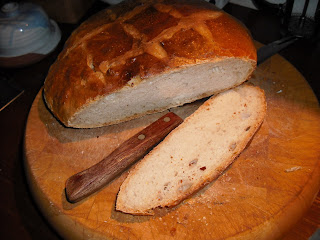To make your bread you need to remove your starter and pour into a bowl. Add 250g of strong unbleached bread flour and 375ml of room temperature water. Give it a good stir and cover with a tea towel and leave in a warm place overnight. Next day this will be a bowl of bubbles and froth. This is what is called your Sponge.
Take approximately three quarters of this sponge and add 300g of flour to it as well as a tablespoon of olive oil, salt to taste and enough warm water to make a smooth dough. Mix on a low speed with a dough hook. The remaining sponge is your starter and just pop it back into a clean dry jar for use next time. Remove your dough when it feels smooth and silky and when you stretch it, it feels like bubble gum. This means the gluten has been stretched and unravelled and is now flexible enough for the bubbles of carbon dioxide produced by yeast metabolism to raise the bread. You now need to prove the dough which means leaving it somewhere warm and with no drafts for about 8 hours. Sour dough rises slowly and sedately unlike commercial yeast bread production. The longer you leave it the more the flavour will develop. Remove, knock back and allow to prove for a second time. This can take up to four hours or longer. Place in a hot oven on a baking tray or in a tin and place a container with some water in the oven to create steam to help crust development. Bake as you would a normal yeast dough and then remove and cool.
The portion of the sponge that you have retained becomes your starter and you need to keep this in the fridge for use next time. However you do need to feed it at least once a week, by repeating the procedure when you first started to make your starter. Throw away half of it and add more flour and water in equal proportion. Give it a good stir to aerate it and put back into fridge. If you have to go away it will survive but just give it a good feed in advance and feed it again when you return. Remember it is a living thing!
Sour dough bread takes time to make but there is not a lot of work involved. I find if you time it right, it takes very little work on your part.
Sour Dough Bread Sour Dough Starter Bread Recipes



Can I rescue a sourdough starter that has been in the fridge unfed for 3 months?
ReplyDeleteI would give it a go. Take it out and throw half away and feed it and leave at room temperature and see does it become active. Feed for a few days and if no sign of activity I would throw it away and start again.
ReplyDelete